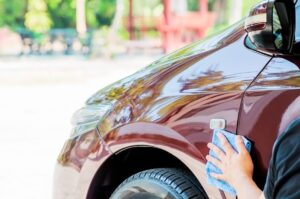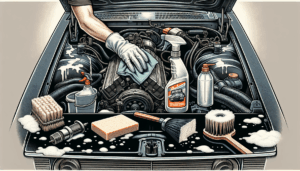Are you looking to give your vehicle or boat a professional-looking finish? Look no further! In this article, we will explore the top 5 tips for DIY ceramic coating application. Whether you’re a beginner or have some experience, these tips will help you achieve that glossy, protected look without breaking the bank. With our helpful guidance, you’ll be able to enhance the appearance of your vehicle or boat and make a lasting impression wherever you go. Read on to discover the secrets to a successful DIY ceramic coating application.

1. Choose the Right Product
Before starting the ceramic coating application process, it is important to do some research on different ceramic coating options available in the market. There are various brands and types of ceramic coatings, each offering different features and benefits. Take the time to understand what each product offers and choose one that aligns with your specific needs and requirements.
Another important consideration when choosing a ceramic coating is your skill level and experience. Some coatings may require more expertise to apply, while others may be suitable for beginners. Assess your abilities and choose a product that you feel comfortable working with.
Reading reviews and recommendations from other users can be extremely helpful in making an informed decision. Look for feedback on the durability, ease of application, and overall performance of the ceramic coating. This will give you a better idea of what to expect and help you choose a product that has been proven to deliver satisfactory results.
Lastly, always opt for a high-quality ceramic coating to ensure the best possible outcome. Cheaper alternatives may not provide the same level of protection and longevity as reputable brands. Investing in a high-quality product will not only give you peace of mind but also ensure that your vehicle is well-protected.
2. Start with a Clean Surface
Before applying the ceramic coating, it is crucial to start with a clean surface. This will ensure proper adhesion and maximize the effectiveness of the coating.
Thoroughly wash and dry your vehicle using a high-quality car wash soap and a microfiber cloth. Remember to pay attention to all areas, including the nooks and crannies, to remove any dirt, grime, or residue that may be present.
After the washing process, use a clay bar to remove any contaminants that may still be clinging to the surface of the vehicle. This includes things like tree sap, tar, and industrial fallout. Simply lubricate the surface with a clay bar lubricant and gently rub the clay bar over the surface to pick up any remaining contaminants.
Once the surface is clean and free of contaminants, it is important to polish and remove any imperfections. This can be done using a dual-action polisher and a suitable polishing compound. Polish the surface in a circular motion to remove any swirl marks, scratches, or oxidation.
Lastly, ensure that the surface is smooth and free of any wax or sealant. A wax remover can be used to remove any existing wax or sealant, allowing the ceramic coating to bond properly to the surface.
3. Follow the Application Instructions
When it comes to applying a ceramic coating, it is essential to read and understand the product instructions thoroughly. Each ceramic coating may have specific application requirements and instructions that need to be followed for optimal results.
Before starting the application process, prepare the product as directed. This may involve shaking the bottle, mixing any required components, or diluting the coating with a specific solvent. Following these preparation instructions will ensure that the ceramic coating is ready for application.
When applying the ceramic coating, it is important to do so in thin layers. This will allow for better coverage and ensure a more even coating. Apply the coating using a suitable applicator, such as a microfiber sponge or an applicator pad, and work in small sections to maintain better control.
After each layer of coating has been applied, it is crucial to allow adequate curing time between layers. This will vary depending on the specific product, so refer to the instructions for guidance. Rushing the curing process can result in a less durable and effective coating.
4. Use Proper Application Techniques
To achieve a professional-looking ceramic coating, it is important to use proper application techniques. This will ensure that the coating is applied evenly and without any visible imperfections.
Working in small sections is highly recommended as it allows for better control over the application. This is particularly important when working on curved surfaces or areas with intricate details. By focusing on smaller sections, you can ensure that each area receives the necessary attention and coverage.
Applying even pressure during the application process is crucial for a uniform coating. This can be achieved by using a firm yet gentle hand when spreading the coating. Avoid applying too much pressure, as this can lead to uneven application and potential damage to the surface.
Using appropriate applicator tools is also important for a successful ceramic coating application. Look for tools specifically designed for ceramic coatings, such as microfiber sponges or applicator pads. These tools are designed to provide even coverage and minimize the risk of introducing scratches or swirl marks.
Lastly, be mindful of overlapping or uneven coating. As you apply the ceramic coating, ensure that each pass slightly overlaps the previous one to ensure full coverage. Take your time and be thorough to achieve the best results.

5. Maintain and Protect the Coating
Once the ceramic coating has been applied, it is important to maintain and protect it to ensure its longevity and effectiveness. By following these maintenance tips, you can keep your ceramic coating looking its best for years to come.
Avoid washing the vehicle immediately after applying the ceramic coating. This will allow the coating to cure and bond properly to the surface. Refer to the product instructions for the recommended curing time before washing the vehicle.
When it is time to clean your ceramic-coated vehicle, use gentle cleaning methods and products. Avoid harsh chemicals and abrasive tools that can potentially damage the coating. Opt for pH-neutral car wash soaps and soft microfiber cloths to prevent any scratching or marring.
Regularly inspect the coating for any signs of wear or damage. While ceramic coatings are known for their durability, they can still be susceptible to wear over time. Look for any areas that may have lost their hydrophobic properties or are showing signs of fading. Touch up these areas as needed to maintain the effectiveness of the coating.
Additionally, consider applying a maintenance coating as recommended by the product manufacturer. This can help rejuvenate the coating and provide extra protection against environmental elements. Follow the manufacturer’s instructions for applying the maintenance coating, ensuring that the surface is clean and prepped beforehand.
By following these top 5 tips for DIY ceramic coating application, you can achieve a professional-looking finish and enhance the appearance of your vehicle. Remember to choose the right product, start with a clean surface, follow the application instructions, use proper application techniques, and maintain and protect the coating. With proper care and attention, your ceramic-coated vehicle will continue to shine and impress for years to come.





